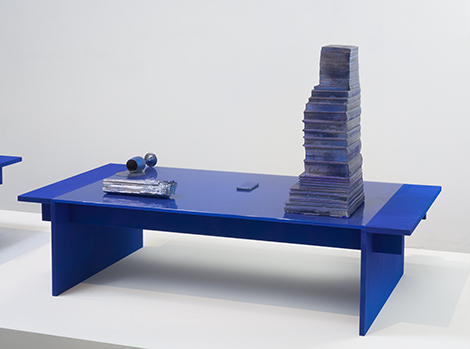Sayre Gomez’s solo offering at François Ghebaly Gallery, “I’m Different,” trumpets its title’s adolescent battle cry across two galleries of new work. Speakers disguised as Froot Loop-hued boulders pipe in the Top 40 from every corner of “The Hypnotic Presence of Popular Music in Southern California,” littering this large-scale multi-channel installation, Gomez’s first, in a calculated clutter. On another of its Dante-esque levels of strip mall hell, black woodchips smother the floor of the gallery anteroom as an armless, faceless mannequin sits, knees touching in stoic angst, on a bench more fit for a food court.
Relieved of its responsibility to art, the installation takes on the exacting nature of a lab in its unforgiving study of things average. The songs overheard throughout the gallery are culled from Facebook-mogul Mark Zuckerberg’s playlist on the music-sharing platform Spotify. Taking advantage of this social media hall of mirrors, Gomez exposes the aesthetics of the Internet itself: prismatic dispersion.
While the defining product of our generation is connectivity, the medium for connectedness remains intangible and almost mythic, with the embarrassing finiteness of data an unglamorous secret sealed away like Google’s servers. As in a prism, reflection and diffusion dominate source and substance in our Internet age. As demonstrated in “Popular Music,” cause is secondary to effect. What survives is a listless labyrinth, where windows open onto other windows.
Closed in on two sides by monochromatic paintings of windows, we are doubly drawn into this world of looking at and looking through. Kid-gloved hands raise a window in one painting, as a generic mountain vista asserts itself blandly the next painting over. This theater of gaze that also dictates the internet image banks from which Gomez gleans inspiration is coated in translucent layers of blues and violets. Colors thicken to incapacitating syrup in the next gallery, coating books, vinyl LPs, a smartphone and a spilled wine glass in situ on Coffee Table in Ultramarine w/Objects.
A cryptic Pompeii, these items of leisure encased in hardened plastic seem archaeological. We study them as if they are clues to a departed era; as art objects, we wonder if they’ve already gone extinct. This bloodless revolution of the ordinary walks us through a cultural graveyard. Large Plinth with Records, marbled in that deep blue, finally lets on. Plinth, as in pedestal, a devotional offering. If Gomez is building a shrine to a lost generation, then whose? In the age of mass customization, “I’m Different” is more war cry than catchphrase, a life raft in our culture of exposure: If only I could outlast the morbidity of the instantly shared image that makes relics of the present moment.
A salvaged window reinstalled by Gomez into the white gallery wall above, Uww (Untitled window work), looks out only to black. Fingernail tracks are visible on the glass. In Gomez’s world, there is no escape, no view; only a broken link.



















0 Comments